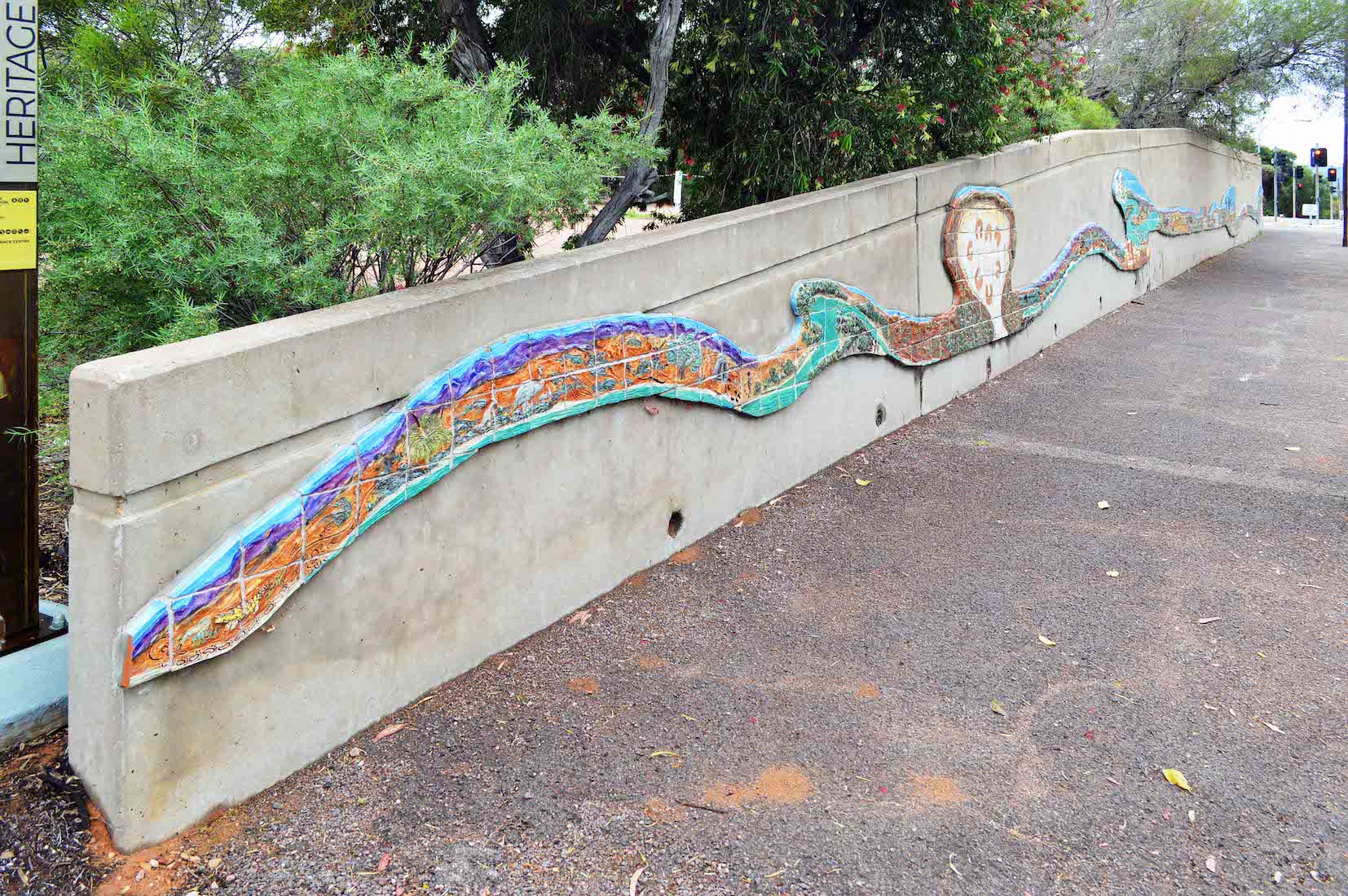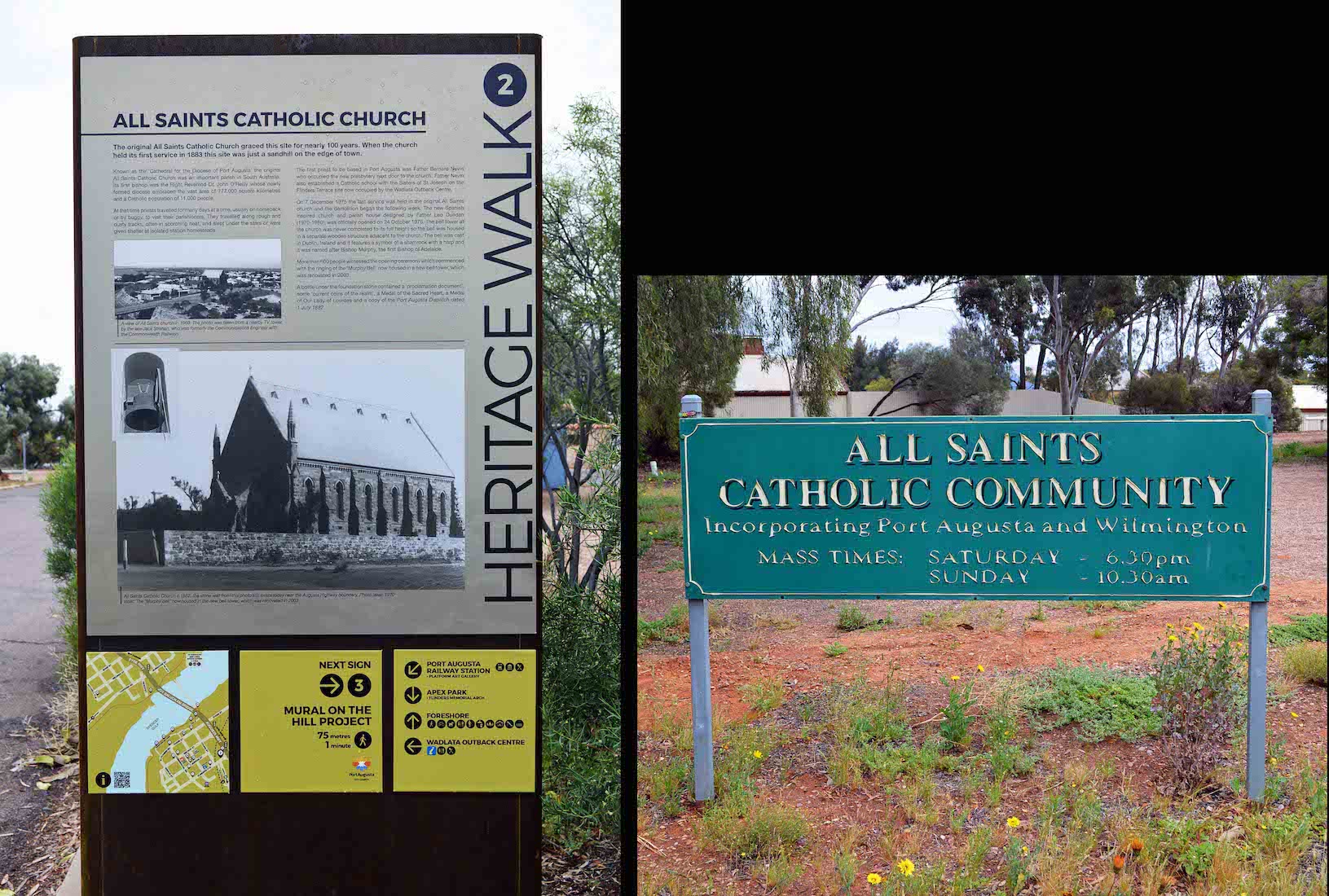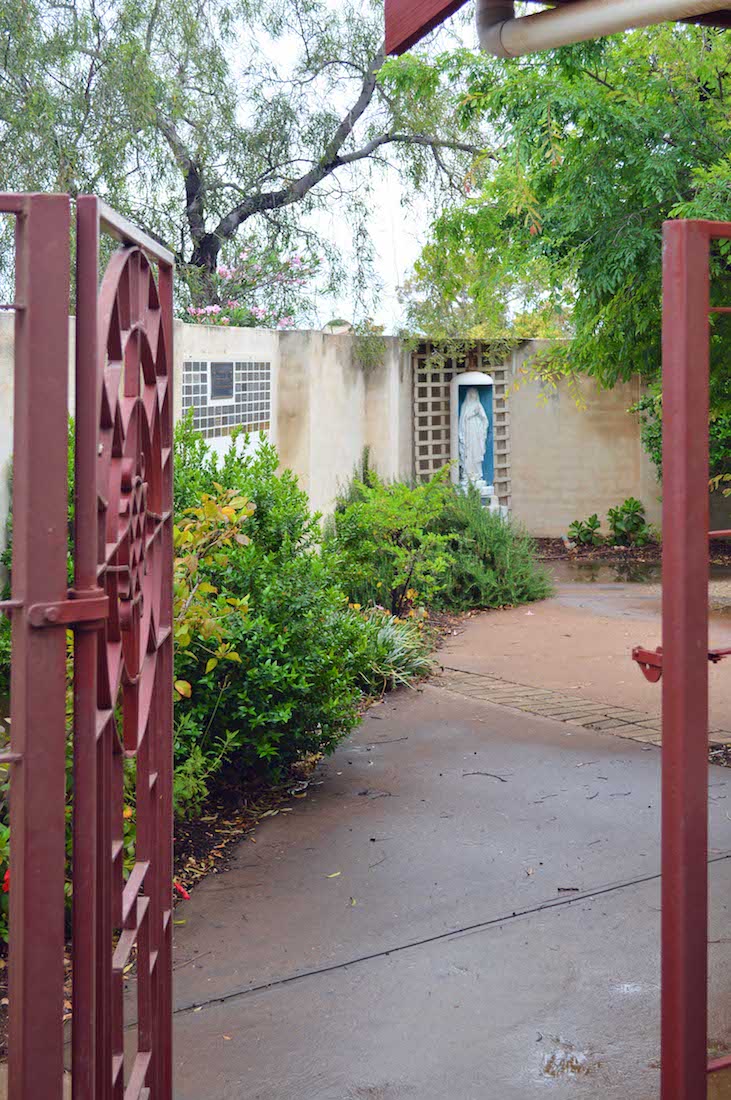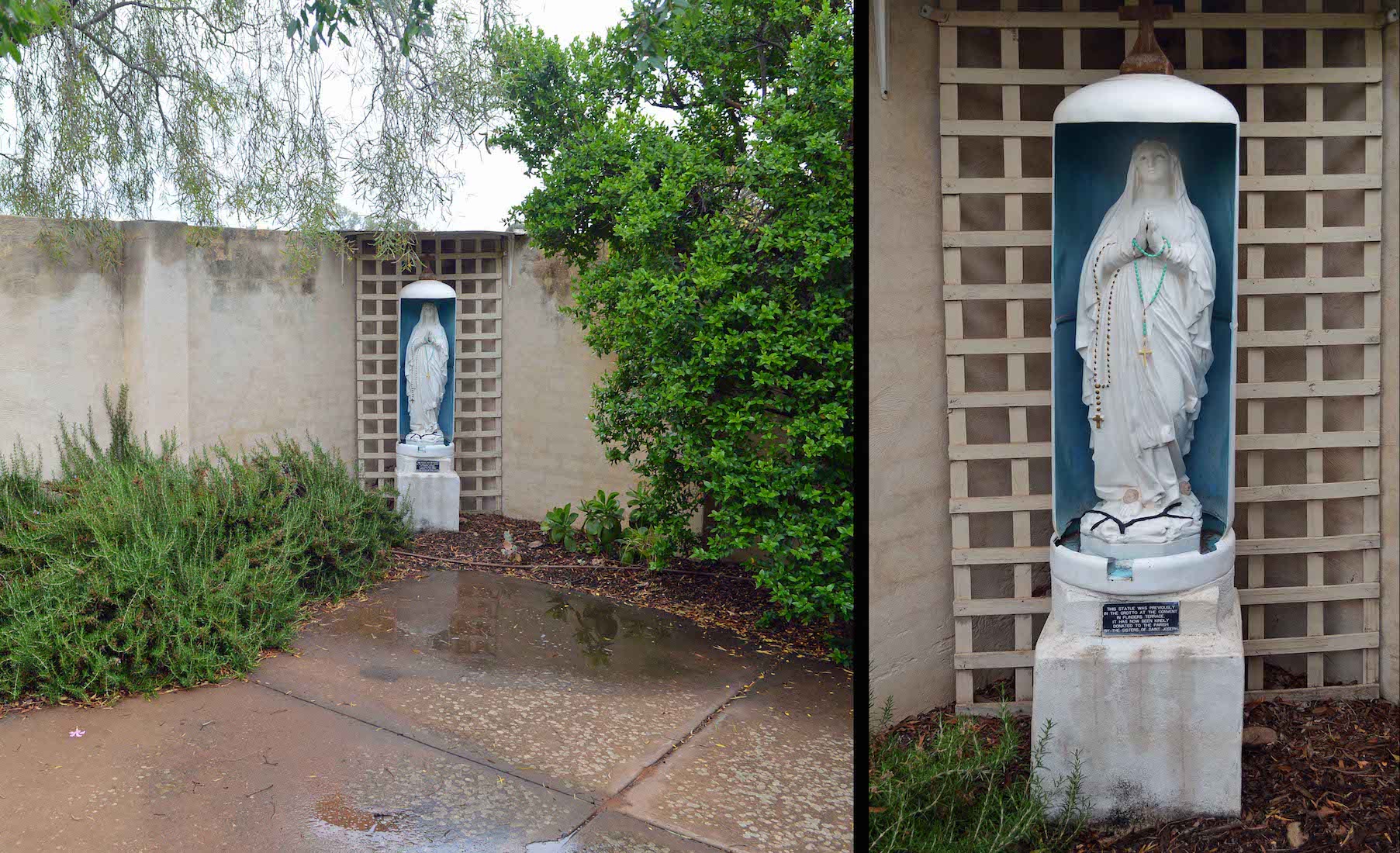
The Church property is bounded on its street sides by a low concrete wall decorated with a colourful aboriginal serpent. Following northwards along the Augusta highway, the concrete wall abuts a section of old stone wall that belonged to the earlier All Saints church. INDEX
2. CHURCH SIGN BOARDS

The Information Board at left stands by the Flinders Terrace entrance. It contains interesting information about the history of the Church. This has been included in the History section on the Title page. I have had difficulty locating any more detailed accounts. The sign board on the right stands in the general parking area, close to the entrance to the church enclosure.
3. ENTRY TO THE INNER COURT
This Church has been designed in a Spanish style, ideally suited to the hot Port Augusta climate. It stands within a walled enclosure, giving it a sense of mystery, but also shielding it from the noise of busy traffic on the two adjoining roads. In this view, the sloping roof belongs to the Church, and the bell tower rises up in front.
4. COURT ENTRY
Arriving at the entry to the walled court, we still can’t see within. We have to pass beneath a simple blue Cross. And the wall ahead contains a rectangle of tiles spelling out a mysterious hieroglyphic. On closer inspection, we see the text of a Bible verse – in fact, Psalm 63:1. ‘God, O God, for you I long, for you my soul is thirsting. My body pines for you, a land parched, weary, waterless. I long to gaze on you in the sanctuary, to see your power and glory.’
5. INNER COURT AREA
On entry we look across a paved area surrounded by garden. It is not waterless, due to a recent shower of rain! The building just appearing on our left is the Church, and an unfortunate mobile tower emerges from behind the shrubbery. There is a gate in the far corner and a pillar with a plaque on the top. And at right in the garden bed is another pillar, with the office entrance beyond.
6. VIEW ACROSS TO THE BELL TOWER
We walk across to the office entrance. The near pillar is now on our left, and from here we can see there is a path between the Church window wall and the bell tower.
7. PLAQUES AND CHURCH WINDOWS
This pillar appears to be the foundation stone of the original Church, carrying the date AD 1882. The top plaque reads: ‘This Church was opened 24th October 1976. It replaces the original All Saints built on this site in 1882. // We remember for the example of their eyes those Catholic people whose faith made these buildings necessary and possible. // Lord hear us.’ •• The second plaque reads: ‘Dedicated to the memory of Father Bernard Nevin 1839 – 1920 First Parish Priest of Port Augusta 1881 – 1889 // From 1874 a pioneer priest, fondly remembered for his dedication to the people. He was a prolific builder of churches and schools. During his 15 years serving the region and parish, Fr Nevin endeared himself to people of all denominations in Port Augusta and surrounds.’ •• The bottom plaque relates to the Cross above the entry: ‘This Cross is a memorial to Fr Linus O’Keeffe C.P., Parish Priest 1981–1989 and all deceased priests and religious who have served this parish // Erected by the Knights of the Southern Cross and parishioners // May they rest in peace.’ •• We follow-the path shown at right as it passes some coloured windows of the Church.
8. BELL TOWER
The bell was cast in Dublin, Ireland, and used in the original Church. We can see the symbol of a shamrock with a harp. The bell also bears the words: ‘Sancta Maria et Omnes Sancti intercedant pro nobis ad domunum’ which means ‘Holy Mary and All Saints intercede for us to the Lord’. The bell was named after Bishop Murphy, the first Bishop of Adelaide. More than 600 people witnessed the opening ceremony which commenced with the ringing of the Murphy Bell, now housed in this bell tower which was renovated in 2003. The path which we are following passes through an arch in the tower. We notice that there are brass plaques at the top of the arch on either side.
9. BELL TOWER PLAQUES
Here are the plaques on the walls of the arch. And a job for the works committee! The first plaque reads: ‘The restoration of the 120 year old bell is dedicated to the pioneers of this parish // It was made possible through the generosity of the Knights of the Southern Cross, Catholic Women’s League, Pt Augusta City Council and the good will of our parishioners // also the efforts of Fr David Wilke C.P. // The bell was blessed by the Most Reverend Bishop Hurley, Bishop of the Diocese of Port Pirie on this day, 29 February 2004.’ The text of the second plaque reads: ‘The people of All Saints Parish gratefully acknowledge the kind donation by Port Augusta City Council towards the restoration of the Murphy Bell which was blessed by the Most Reverend Bishop Hurley, Bishop of the Diocese of Port Pirie on this day, 29 February 2004.’
10. COURTYARD
Our path now leads through a wrought iron gateway to another spacious but intimate walled courtyard. From here we notice on the left wall the funeral plaques of a columbarium. Further along is a blue and white statue which makes me think of Lourdes!
11. FUNERAL PLAQUES
The central plaque reads: ‘Remember Lord, those who have died and gone before us.’ This is a much more sensible memorial than the older spread-out cemeteries, although they do retain their appeal. These plaques also require regular attention to keep them legible and hence meaningful.
12. COURTYARD
Bernadette Soubirous was a 14-year-old daughter of a miller in the town of Lourdes in southern France. From 11 February to 16 July 1858, she reported 18 apparitions of ‘a Lady’. ... Soubirous was canonized a saint in 1933 by Pope Pius XI. These days, many Catholic churches have a ‘grotto’ with a statue of Bernadette. The plaque here reads: ‘This statue was previously in the grotto at the convent in FlindersTerrace. It has now been kindly donated to the parish by the Sisters of St Joseph.’
13. WIDER COURT
We retrace our steps back past the bell, and into the wider courtyard we first entered. Past the garden seat is the corner plaque and column with 1882 visible.
14. PLAQUE
This plaque has text: ‘1882 – 2002 Celebrating the future by celebrating the past. // In this, our 120th Anniversary of All Saints Catholic Community, we pay our respects to the original custodians of the Port Augusta region who saw this land full of natural beauty. // We acknowledge these Indigenous people of yesterday and their descendents who today are an integral part of our community. // We pray for all who continue to celebrate their faith in this sacred place. // 4 May 2002
15. CHURCH WEST WALL
From our position by the pillar we turn to view the West wall of the Church with the Murphy bell behind. The outstanding feature here is the large stained glass window which lets light into the narthex.
16. ENTERING THE NARTHEX
We enter the narthex by the door closest to the main court entry. It is a large and impressive foyer with the large window to our left. To our right a sloping link aisle leads down to the nave. Other notable features are the painting at our extreme left, a Virgin and Child in a glass case above the servery, and ahead, a display involving a half wheel and ropes.
17. VIRGIN AND CHILD
Mary and the Child Jesus look out a little sadly from their confined space. Mary is dressed in her traditional blue, representing her purity, and to label her as an empress, for blue was associated with Byzantine royalty.
18. NARTHEX WHEEL DISPLAY
This interesting display contains part of the wheel of the original All Saints Church bell. The Murphy Bell was cast in Dublin in 1884. It was placed in the tower of the new Church in 1976. In 2003 a new wheel replaced this original wooden wheel. The photographs show some of the buildings associated with the early Catholic community here.
19. NARTHEX WINDOW
This strikingly colourful window dominates the narthex, and in fact can also be seen from the nave. But what does it mean?
20. NARTHEX WINDOW DETAIL
I have been unable to find any information online about this interesting window. The images of the fish and the serpent are recognizable here.



















